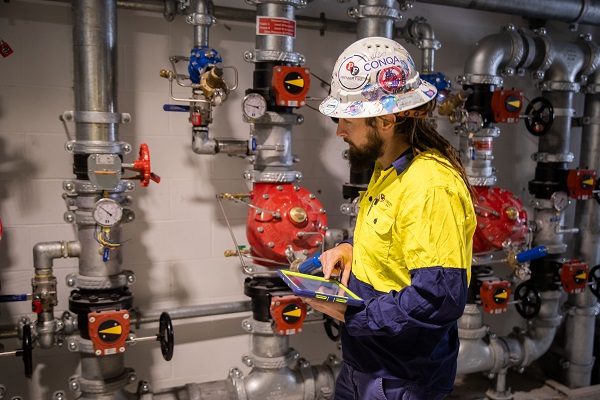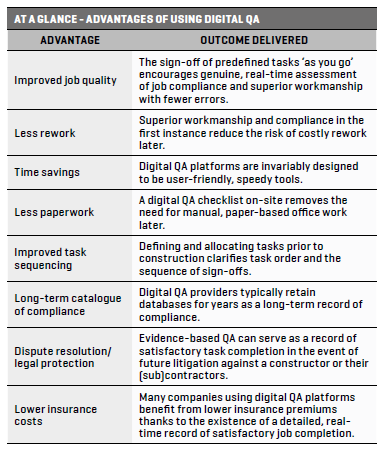Digital QA ticks all the boxes
Historically, worksite quality assurance has been a paper-based, retrospective chore rather than a genuine record of procedural excellence. However, on-site digital QA platforms are changing the way contractors and subcontractors sign off their work. John Power reports.
Digital platforms using mobile devices like smartphones and iPads have affected all industries, including commerce, healthcare, education, retail, hospitality – and now building and construction, most notably in relation to the delivery of evidence-based quality assurance (QA).
ADVERTISEMENT
QA in construction in recent decades has sometimes been a ‘hit and miss’ affair, with many contractors and subcontractors regarding their sign-off obligations as ‘just another step’ in the long bureaucratic journey towards job completion and invoicing.
All that is changing. As happens so often with major worksite innovations, ‘big construction’ (more than 25 personnel) is at the forefront of cutting-edge reforms. This means contractors and subcontractors wishing to gain work with larger companies need to be aware of these new digital platforms – and willing and able to use them. NB: digital QA platforms are increasingly being adopted as mandatory procedures on worksites.
Furthermore, it seems inevitable that digital QA practices will trickle down from larger companies to small-to-medium firms, as smaller outfits gain familiarity with the technology and see the many benefits of keeping ‘as you go’ digital records.
Why is digital QA so revolutionary?
Daniel O’Donoghue, co-founder and Director of CONQA, which creates and manages customised digital QA packages for the construction industry in Australia and New Zealand, says in-the-field digital QA processes allow for real-time data collection (including imagery) that would be impossible using traditional paper-based methods.
The primary motivation for using a digital QA platform, Daniel explains, is quite fundamental: a desire to create better buildings. However, there are plenty of additional advantages of embracing digital QA.
“You remove as much of the guesswork as possible from the process,” Daniel says. “Contractors and subcontractors are professionals – they know what they’re doing – so digital QA is really just there to make sure everyone has completed things right, that everything is in order, and they can just move on with peace of mind knowing they have checked everything.”
By creating a meaningful sign-off process with real-time digital QA, workers are motivated to deliver peak productivity and performance in the first instance. Signing off work ‘as you go’ also removes the need for lengthy, time-consuming, often imprecise, retrospective reviews that can add hours of desk work to a working week or month.
“Digital QA, I should add, is also massively used as a protection device,” Daniel says. “We’ve got examples of customers who have been able to reduce their insurance premiums because they can demonstrate that they have done work correctly: for example, the ability to prove that a fault was attributable to a post-construction incident, rather than the actions of an original construction contractor, can save a construction company from the headaches of litigation and associated insurance payouts.
“Simply ‘minimising risk’ is a powerful incentive for adopting a digital QA system.”
More subtle outcomes can also result from a sound digital QA system. For instance, there is often ambiguity about exactly what needs to be signed off, and in what order in complex systems involving both plumbing and electrical work – a predefined digital QA checklist can help remove these kinds of uncertainties by spelling out the parameters of each task and stating who is accountable for its completion.
Using Digital QA
Digital QA starts with the creation of a project-specific checklist of construction elements that need to be completed and signed off.
Daniel says CONQA, for instance, sits down with project managers and supervisors prior to construction to create a comprehensive, customised database of checklist items. This database, which might include hundreds or even thousands of items in a major project like a high-rise structure, might feature level-by-level tasks involving roughing in, fit off and commissioning.
“Let’s say you’re dealing with a 20-storey building with 10 apartments on each level, and each apartment has three checklist activities. If each activity includes 10 checkpoints, then there will be 6,000 items overall to sign off. One of our customers who is a plumbing contractor working for one of the massive high-rises in Melbourne has over 20,000 checklists they have to do for that project.” (Electrical and HVAC specialists might each handle checklists of similar magnitude.)
Without a real-time digital QA process, extensive checklists can be forgotten, deferred to a later date, or simply sidestepped. “If a checklist is done after the fact, it actually serves very little function,” Daniel adds. “So, our philosophy is to focus on our customers, and to make it as easy as possible for that site supervisor or end user supervising their crew to do these checks.”
Ease of use is a critical component of any workplace QA platform, as large numbers of contractors and subcontractors with varying levels of competence using new technologies need to get up to speed quickly and painlessly.
“Simplicity is probably our biggest asset because you get engagement,” Daniel reiterates, explaining that even senior tradespeople generally have no difficulty coming to grips with checklist processes. “We offer training anyway, so useability is not really an issue.”
CONQA clients like Lend Lease, Multiplex, Scentre Group, Kapitol Group, and others are clearly forging new trends in the adoption of digital QA platforms. And even though most major construction works continue to depend on paper-based QA records, the balance, as mentioned, is shifting.
“In Victoria, we’re seeing significantly fewer quality issues when subcontractors use CONQA,” says Matt Monger, QA Manager at Multiplex.
-
ADVERTISEMENT
-
ADVERTISEMENT



